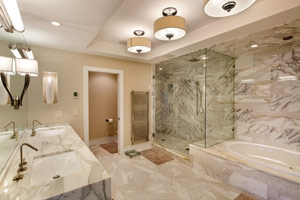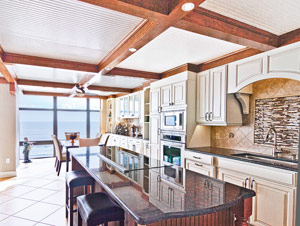
WHAT'S HOT IN KITCHENS & BATHS
 With more people choosing to stay put, remodeling is faring well. And, as usual, kitchens and bathrooms are the most popular remodeling projects, both locally and nationally.
With more people choosing to stay put, remodeling is faring well. And, as usual, kitchens and bathrooms are the most popular remodeling projects, both locally and nationally.
If you’re considering anything from a minor facelift to a total rehab, you’ll be interested in learning about what’s hot in fixtures, furnishings, materials and colors.
The National Kitchen & Bath Association (NKBA) has identified some intriguing kitchen and bathroom design trends following its annual Design Trends Survey, which asked industry pros nationwide what their customers are asking for.
More than 300 designers participated in the organization’s 2013 survey, reporting the materials, products and styles that they specified in their kitchen and bathroom projects over the final three months of 2012.
Following are the top overall trends that emerged for kitchens and baths across the U.S. and Canada.
REMAINING NEUTRAL
In kitchens, use of grays has soared over the past three years. In 2010, fewer than one in 10 kitchens were decked out in gray. Now more than half prominently feature gray hues.
Even so, white and off-whites continue to be the most popular color schemes in both the kitchen and bathroom. Other frequently used colors for kitchens and bathrooms include beige and “bone.”
Brown, bronze and green have become more popular in kitchen remodels, while green and blue remain frequently used colors in bathrooms.
SHIMMERING SURFACES
In kitchens, granite and quartz continue to rank No. 1 and No. 2, although quartz has narrowed the gap significantly. Marble remains the most popular material for bathroom vanity tops.
A nice backsplash can tie any kitchen together. Interestingly, the most popular material right now is not tile, as you might expect, but glass.
More than half the designers surveyed reported using glass on a backsplash. Glass provides a sheen that meshes with another trend: surfaces — and even appliances — that carry a polished high gloss.
IF YOU WOOD
Cherry cabinets used to be the gold standard, but designers reported a drop in use of cherry wood this year. More designers are using other woods, such as walnut, birch, bamboo or alder.
Light natural finishes on cabinets are also falling out of favor, with dark and medium finishes predominating.
Among painted cabinets, white continues to be the most popular option, used by nearly seven in 10 designers this year. Other colors were named by fewer than 40 percent.
Another intriguing trend to note: distressed finishes are making a comeback. Just 5 percent of designers used distressed finishes last year, while the number soared nearly 25 percent this year.
 TRANSITION TIME
TRANSITION TIME
For the second consecutive year, the transitional style has trumped the traditional style in kitchens and bathrooms.
The transitional style, which blends elements of traditional and contemporary, actually expanded its lead and is now the style of choice in 69 percent of kitchens and 61 percent of bathrooms.
Contemporary comes in at No. 3, used in just over half of kitchen designs, while Shaker, arts and crafts and cottage round out the list.
FOLLOW THE LED
Light-emitting diode (LED) lights are more expensive than traditional bulbs at the outset, but they’re also more efficient and can save money on energy bills in the long run.
No wonder, then, that 77 percent of designers now report using them. Just 50 percent specified LED lighting in 2010.
Compact fluorescent lights (CFLs) don’t fare as well, despite using roughly one quarter of the energy of an incandescent bulb. Only 26 percent of designers report using them, due mostly to the poor quality of light they emit and the presence of mercury inside the bulbs.
FABULOUS FAUCETS
Pull-out faucets predominate in both kitchens and bathrooms because they’re so handy to use, especially when rinsing dishes. Also, they come in an array of colors and styles and fit with any design concept. So it’s not surprising that more than nine out of 10 designers surveyed reported using pull-out faucets this year.
Touch-activated faucets, however, are increasing in popularity, used in 32 percent of projects now versus 20 percent last year.
Pot filler faucets moved into second place in this year’s survey, jumping from 28 percent to 33 percent.
FINE FINISHES
When it comes to faucet finishes in kitchens, satin nickel has been on top since 2011, its use increasing from 42 percent in 2010 to 60 percent now.
Bronze or oil-rubbed bronze finishes are also being specified more often, growing from 41 percent to 50 percent versus last year.
The increased popularity of these three finishes has most likely come at the expense of polished nickel and polished chrome, both of which declined in this year’s survey.
FLOORS AND SINKS
Ceramic or porcelain tile remains the most popular flooring material in bathrooms, specified by 83 percent of designers. However, that’s down slightly from 2012.
Although still in second place, natural stone tiles have also declined, dropping from 77 percent in 2011 to 57 percent this year.
As far as sinks are concerned, undermounts are far and away the most popular variety, and have occupied the top spot for three consecutive years.
THE BOTTOM LINE
In the annual NKBA Design Trends Survey, designers are asked for the total average cost of the kitchens they design, including materials and labor. In 2010, the figure was $44,800; in 2011, it dropped to $40,500. In 2012, the figure rose significantly to $51,050. However, this year’s survey saw another modest decline, to $47,308. In 2010, bathroom remodels stood at $18,575 and dropped to $16,475 in 2011. But the average expenditure increased to $18,850 in 2012 and has held virtually even at $18,538 so far this year.
GO GREEN
AN ECO-FRIENDLY KITCHEN IS ALSO A HEALTHY KITCHEN
A green kitchen sacrifices nothing in terms of comfort and beauty. And it fosters a more healthful home environment while conserving natural resources and lowering utility bills.
So more homeowners are opting for natural and renewable materials, such as stone and bamboo flooring as well as recycled-content products for countertops and backsplashes.
Green is healthier, too. The air in a typical home is full of pollutants, especially in the kitchen, where chemicals in cabinets, flooring, furnishings and paint “offgas,” and where smoke and cooking smells can escape into the rest of the house if ventilation is inadequate.
In a green kitchen, materials and equipment should be chosen for their health-positive or health-neutral qualities.
For example, ventilation and range exhaust systems with efficient and effective engineering design can quickly expel stale air from the home and bring in fresh, clean air.
A kitchen designed with the environment in mind will also have a range exhaust system that’s properly configured and sized so it uses no more energy than needed and will remove pollutants generated at the range top in an efficient, healthy and quiet manner.
Today’s homeowners are savvy about appliances; they want attractive, high-quality, user-friendly, Energy Star-rated products. Technology makes it easier to prepare meals that are better tasting and more healthful — and don’t require all day in the kitchen.
For example, the eco-friendly trend is having an impact on the growth of induction cooking, which is a quick, efficient method that uses a strong electromagnetic field to cause the pan to get hot instead of the cooktop. When the pan is removed, the cooktop becomes cool to the touch.
Even refrigerators are sporting better engineering design, with compartments that can help prolong the life of stored food. When a drawer is sealed, for example, it can decrease evaporative loss.
Filtered air can also prolong the freshness of food while filtered water can improve the taste.
